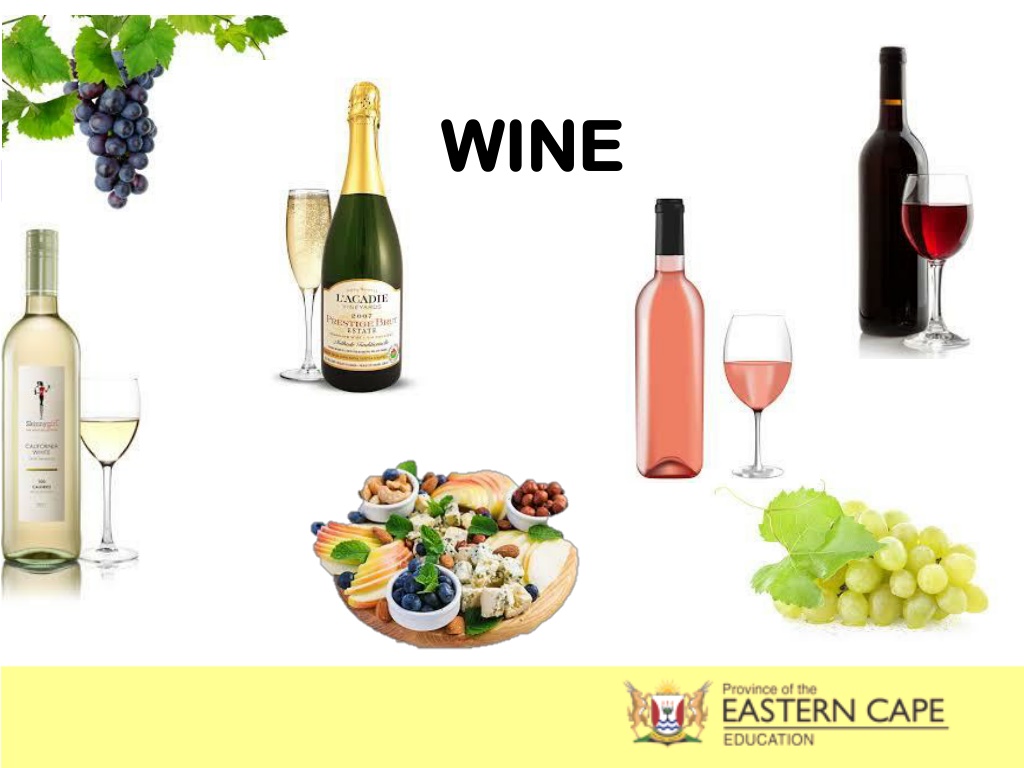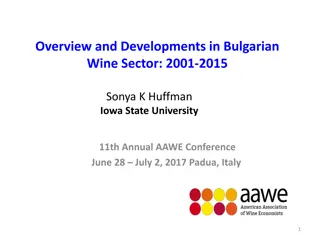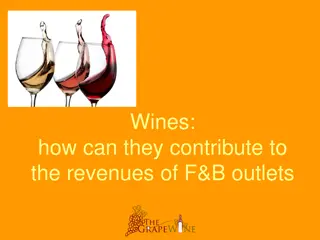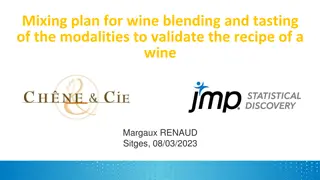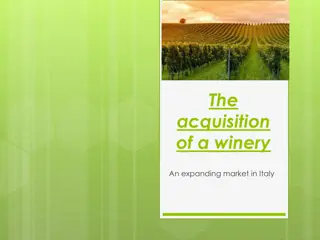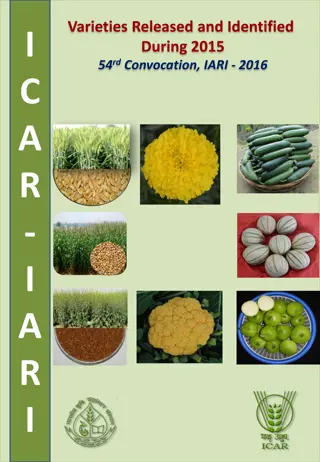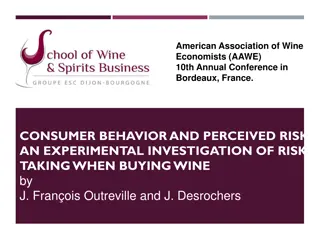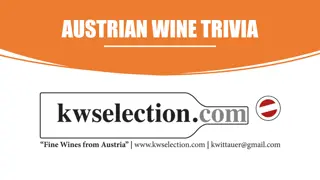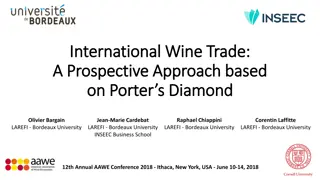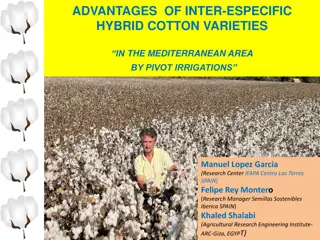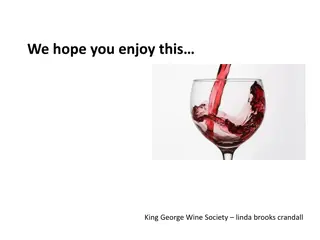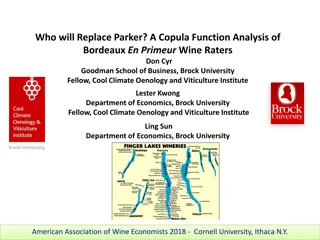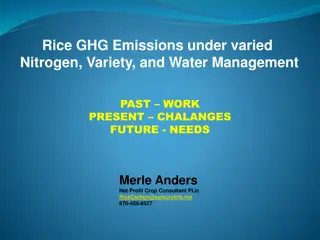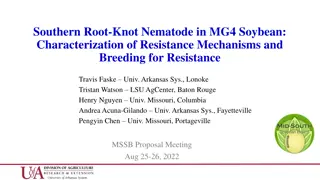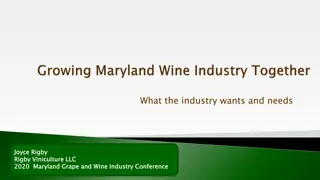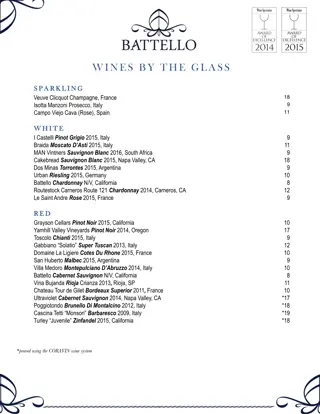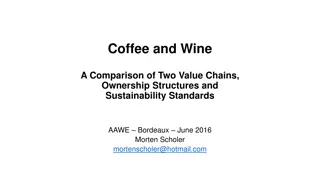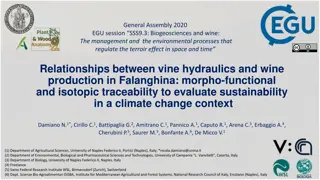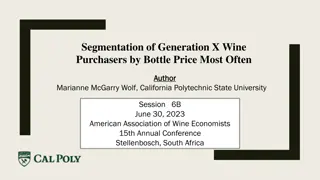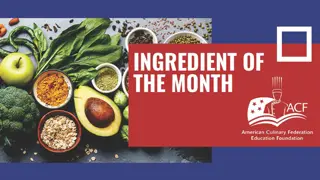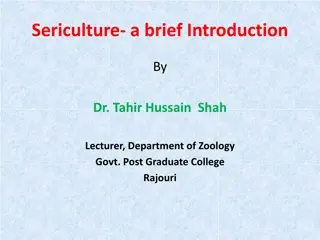Explore the World of Wine: Types, Varieties, and Making Process
Wine, an alcoholic beverage made from fermented grape juice, comes in various types such as sparkling, fortified, and still wines. Discover the classification of wines and the nuances of grape cultivars used in winemaking. Learn about the marking process, characteristics of white and red wines, and popular grape varieties like Chardonnay and Cabernet Sauvignon.
Download Presentation

Please find below an Image/Link to download the presentation.
The content on the website is provided AS IS for your information and personal use only. It may not be sold, licensed, or shared on other websites without obtaining consent from the author. Download presentation by click this link. If you encounter any issues during the download, it is possible that the publisher has removed the file from their server.
E N D
Presentation Transcript
WINE WINE
Wine is an alcoholic beverage made by fermenting the juice of fresh grapes. The grapes are grown specifically for this purpose. Grapes are different from table grapes. Guests in restaurants will ask for advice about suitable wines to accompany their meal. DEFINITION Knowledge of the different types of wines will allow you to recommend an appropriate wine to accompany a particular dish. Wine is not only the result of the fermentation of grape juice but is the culmination of many factors that greatly affect the finished product. First and foremost are the grape itself. The many varieties of wine grapes grown worldwide produce varying degrees of sweetness, flavor, acidity, tannins
Still / Natural wines CLASSIFICATION Sparkling wines Non-alcoholic / Low alcohol wines Fortified wines
STILL / NATURAL WINES Wine that has no bubbles. Referred as table wines. Nothing has been added during the fermentation process. The different varieties of grapes used to make wine are called cultivars. Cultivars: wine grape varieties that are the building blocks of the craft of wine making.A cultivar is a grape variety which has been selectively cultivated. The main difference between cultivars is the colour of grapes used for making white, ros and red wines.
WINE MARKING PROCESS Pressing: White- juice separated from skins Red-skins left Fermentation: Sugar converted into alcohol and carbon dioxide Grapes destemmed and Crushed = MUST Labelling and Sealing Grapes are harvested Bottling Clarification Blending
Light skinned grape varies from pale green to gold. Made using green and black grapes, if black grapes are used skin must be removed before crushing Based on sugar content = very dry, dry, semi-sweet, sweet Chenin Blanc Sauvignon Blanc WHITE WINE Rhine Riesling Chardonnay CULTIVARS Gew rztraminer Paarl Riesling Colombar
Usually dry, produced in wooded or unwooded styles. Made using black grapes and the skin remains through the fermentation process Available as a single cultivar or a blend of two or more types of grapes RED WINE Cabernet Sauvignon Merlot Pinotage Shiraz Cabernet Franc CULTIVARS Pinot Noir Cinsaut
Can be dry, off dry,semi-sweet ROS WINE Made from red grapes and the skins are removed from the juice as soon as a rosy colour appears Made by blending red and white wine
Large carbon dioxide bubbles. Carbonated by fermentation or by inserting carbon dioxide. METHODS SPARKLING WINE CapClassique: Second fermentation occurs in the bottle Carbonation: Carbon dioxide is injected into the wine Charmat/Tank: Second fermentation occurs in the tank DEGREE OF SWEETNESS Brut = Very dry Sec = Dry Demi-sec = Medium dry (slightly sweet) Doux = Sweet
ALCOHOL FREE, DEALCOHOLISED AND LOW ALCOHOL WINE ALCOHOL FREE: Grape juice concentrate and grape juice. Unfermented DEALCOHOLISED: Alcohol has been removed Made the same way as normal wine but alcohol removed before bottling Less than 0.5% alcohol
FORTIFIED WINES Non-sparkling Wines in which spirits are added Fermentation stops by addition of spirit TYPES: Sherry Port
Back Label Authenticity Seal WINE LABEL Descriptive information WINE LABEL LEVILE S WINERY Merlot Plum flavours, touch of oak and chocolate. Serving Suggestions: Compliments Beef roast, pasta and steak Serving Temperature: 16 C 14%alc750ml Producer LEVILE S WINERY Vintage Serving Sugg. Merlot 2019 Robertson Cultivar Origin 14%alc 750ml Serving Temp Alcohol Content Volume Barcode Front Label
Acidic flavours such as vinegar or lemon need to be MATCHING FOOD AND WINE MATCHING FOOD AND WINE matched with acidity Starters pair well with a dry white / rose wine Fish, poultry and shellfish pair well with a dry white wine Veal, pork pair well with a medium white wine Game meat are complemented by red wines Rich red wines pair well with red meat dishes Sparkling wine complements most foods but mostly for caviar and oysters Desserts require sweeter wines / port Cheese blends well with port and dry red wine Drink white wine before red wine Drink dry wine before sweet wine Serve a good wine before a great wine
Ideally an underground cellar free from vibrations. Vibrations will affect the quality of the wine Cellar must be free from dampness and unwanted odours STORAGE OF WINE STORAGE OF WINE Cellar must be clean and well ventilated Ideal temperature is 10-16 C Similar wines must be stored together Wine must be rotated regularly When stored in boxes arrows should face up Bottles must be kept on their sides so the corks stay moist and swollen. If air goes in the wine becomes sour
Selling aid usually compiled by a sommelier . Other beverages are often included in a wine list Listed in the order in which they may be consumed Grouped according to the type of drink BASIC BEVERAGE AND WINE LIST Aperitifs Aperitifs- -sparkling wine, fortified sparkling wine, fortified wines, mineral water wines, mineral water *** *** Cocktails Cocktails *** *** Spirits Spirits *** *** Wines (Still and Sparkling) Wines (Still and Sparkling) *** *** Beer Beer *** *** Liqueurs Liqueurs *** *** Speciality Coffees Speciality Coffees *** *** Non Non- -alcoholic drinks alcoholic drinks
SERVING TEMPERATURES, CORRECT Rinse in warm water Polish glasses by hand Shine by holding over a container of boiling hot water to steam it and shine with a glass cloth Ensure that no fibres from dishcloths stick to the glasses Store glasses right side up or hanging upside down WINE TEMPERATURE 6-8 C 7-12 C 7-12 C 15-20 C / Room temperature Sparkling wine White wine Ros wine Red wine AND CLEANING GLASSES White wine Glass Sparkling Wine Glass Red Wine Glass
TOOLS FOR THE CORRECT SERVICE Ice bucket: Chills sparkling/ white wine, Ros wines Wine Cradle: For presenting and pouring red wine, angle allows the sediment to settle at the bottom of the bottle OF WINE Wine opener/Waiters friend/ Corkscrew: opens wine bottles Service Cloth: Used to absorb water when the bottle is removed from the wine cooler Decanter: Old vintage wine may need to be decanted to ensure that the sediment remains in the bottle
Strict laws regulate the sale of alcohol to the public. Laws governed by the Liquor Act No 59 of 2003. REGULATIONS FOR SERVING WINE OFF CONSUMPTION LICENSES ONCONSUMPTION LICENSES Includes liquor stores, grocers etc Sell liquor BUT may NOT all the opening or drinking of alcohol on their premises. Includes hotels, restaurants, pubs, theatres, clubs etc.. They are allowed to serve liquor with a meal BUT are NOT allowed to let guests remove open bottles of alcohol from the premises DISQUALIFICATIONS ON PREMISES GENERAL REQUIREMENTS FOR ON CONSUMPTION A person who has in the preceding 10 years been sentenced to imprisonment No person under the age of 18 may be served alcohol A person who is an rehabilitated insolvent Enough guest toilet facilities for males and females must be provided A person who is a minor on the date of application Ordinary meals should be available during hours when liquor is sold A husband or wife of the above persons Any violation of the law may results in the loss of the license
1. Study the scenario below and answer the questions that follow ACTIVITES 1.1 Match each dish named in the scenario above with a suitable wine cultivar. Lime Grilled Chicken Caesar Salad: White wine Smoked Salmon and Caviar: Champagne Lamb Shanks: Red wine Cherry Turnovers with Macadamia Nut Ice Cream: Dessert wine, sweet white wine, port (Any suitable example) (4)
1.2 Advise the restaurant manager on how to store the wine correctly. (4) The wine: needs to be kept in the dark to avoid damage from ultraviolet light should preferably be stored in a damp location should be free from vibration bottles should be placed on their sides so that the corks stay moist should be rotated on a regular basis that is similar should be stored together bottles should be packed and stored with the label to the top or to the front cellar should be clean and well ventilated should be stored upside down in a box (Any 4)
2. Study the wine label below and answer the questions that follow. 2.1 Classify the wine above. (2) Natural / Still / Red wine / dealcoholized wine (Any 2
2.2 Refer to the wine label above and give the following information: (a) Cultivar (1) Cabernet Sauvignon (b) Producer Ariel (c) Class designated name (1) Dealcoholized (1) 2.3 Study the dishes below and identify TWO suitable and TWO unsuitable dishes for the wine in QUESTION 2.1.
2.4 Determine the procedure you will follow when presenting this wine to a guest. (4) -Stand on the right-hand side of the guest -Hold the wine selected on a service cloth -Label must face towards the guest -Present the wine to the host whilst saying the name and vintage of the wine to confirm that it is the correct one -Open the bottle once the host is satisfied -Permit the guest to feel the temperature of the wine if they wish to do so. (Logical order - Any 4
2.5 Ndumiso has failed several times to secure a liquor license. Discuss the statement above. (3) Ndumiso might be failing to secure a liquor licence due to the following: -In the preceding 10 years, been sentenced to imprisonment, for any offence, without the option of a fine -Rehabilitated insolvent -A minor/under 18 on the date of consideration of the application -A husband of any of the above persons -The restaurant is next to the school and no permission is granted from the community. (Any 3
